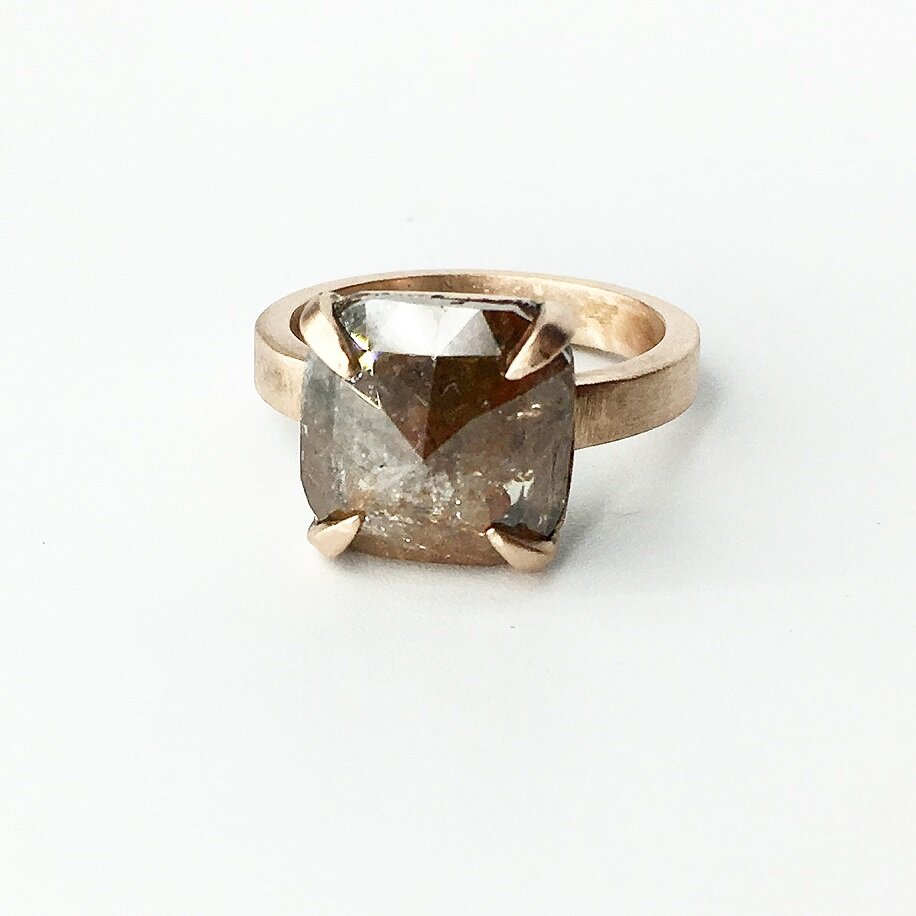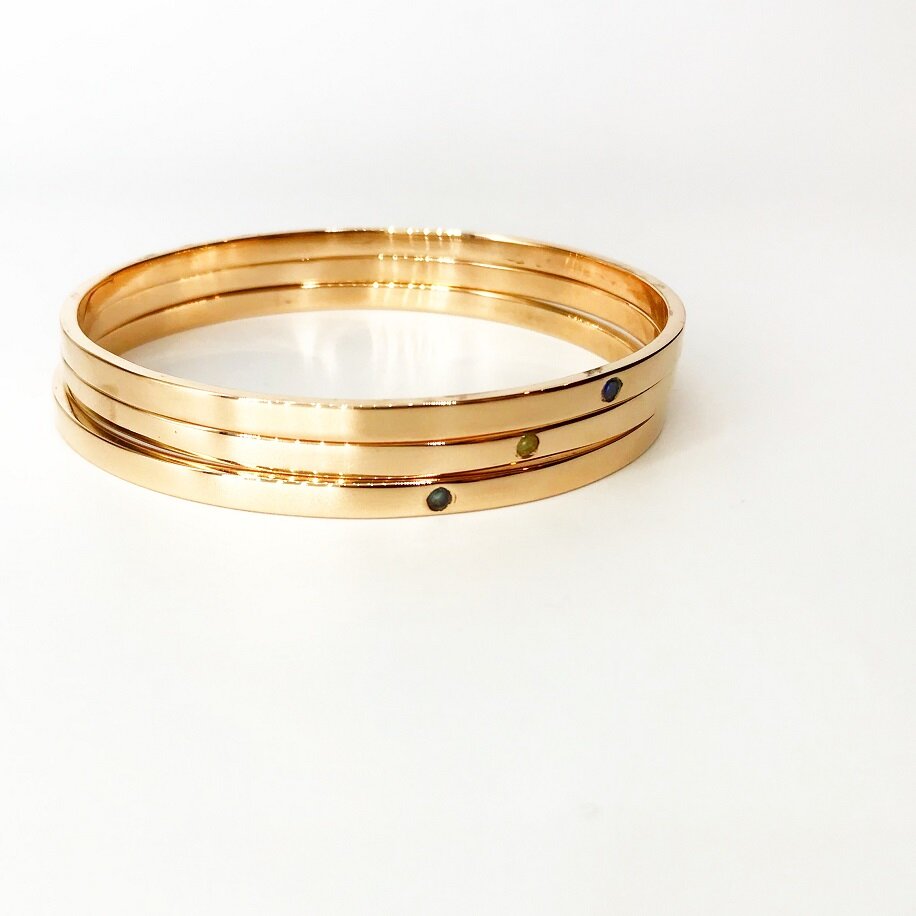On Metals, part 2: Gold
For our first “On Metals” post, I introduced you to the elements platinum and palladium, two white metals that have some pretty cool histories and uses (if you’re into that sort of thing). Now, allow me to walk you through the glittering world of gold, another noble metal on the periodic table with some pretty amazing qualities.
Your ring has some space dust on it...
 Gold is a naturally yellow, extremely malleable elemental metal that has been used in jewelry making for millenia. It is likely that the material originated in the far reaches of the universe, billions of years ago, and arrived as dust on Earth soon after the planet’s formation. How cool is that?While the aesthetic beauty of gold is certainly its alluring appeal, jewelers prefer working with gold for its malleability, the fact that it never tarnishes, and that only a handful of rare acids or hot chlorine bleach can damage it. These qualities make it relatively easy to reuse by melting down old settings, coins, and even gold shavings to make “new” pieces. Also, unlike platinum, you can melt gold using a standard torch and you don’t need lots of special equipment to handle the metal.
Gold is a naturally yellow, extremely malleable elemental metal that has been used in jewelry making for millenia. It is likely that the material originated in the far reaches of the universe, billions of years ago, and arrived as dust on Earth soon after the planet’s formation. How cool is that?While the aesthetic beauty of gold is certainly its alluring appeal, jewelers prefer working with gold for its malleability, the fact that it never tarnishes, and that only a handful of rare acids or hot chlorine bleach can damage it. These qualities make it relatively easy to reuse by melting down old settings, coins, and even gold shavings to make “new” pieces. Also, unlike platinum, you can melt gold using a standard torch and you don’t need lots of special equipment to handle the metal.
“Karats,” not “Carrots” or “Carats”
 The malleability of gold is directly related to its softness. Because gold in its pure form is incredibly soft, it’s often alloyed for jewelry purposes using a mixture of silver, copper, nickel, iron, zinc, tin, manganese, cadmium, and/or titanium. You’ve probably heard about gold’s “karat” value (not to be confused with “carat,” which is used for sizing diamonds). The higher the karat value of the gold, the higher the percentage of gold within metal (and the softer the material). Karats are measured out of a total value of 24 “parts gold.” Thus, 24-karat gold is 100 percent gold (24 parts/24 parts gold), while 10-karat gold is 41.66 percent gold (10 parts/24 parts gold).You’ll most commonly find jewelry in 10-, 12-, 14-, or 18-karat gold, but it is possible to create gold alloys that fall anywhere in between (or below). The karat value of gold is important to know not just for the sake of the piece’s monetary value, but also for the ability to work with it appropriately. Thus, gold is typically stamped with its karat value. While the U.S. uses the “14-kt” system of markings, Europe and other regions use marks that translate to the alloy percentage rather than the parts gold. Thus, a European mark for 18-karat gold is “750”, which reflects the 75 percent gold alloy.Depending on the alloy used, the inherent yellow qualities of the gold can change to a silvery-“white” or a coppery-“rose” color. You can even find gold alloyed to make it blue (alloyed with iron) or green (alloyed with silver, cadmium, or zinc). Just remember, the higher the karat, the more “yellow” the metal will look. My personal favorite right now is 14-karat rose gold, which is a beautiful deep yellow/pink tone that wears exceptionally well.
The malleability of gold is directly related to its softness. Because gold in its pure form is incredibly soft, it’s often alloyed for jewelry purposes using a mixture of silver, copper, nickel, iron, zinc, tin, manganese, cadmium, and/or titanium. You’ve probably heard about gold’s “karat” value (not to be confused with “carat,” which is used for sizing diamonds). The higher the karat value of the gold, the higher the percentage of gold within metal (and the softer the material). Karats are measured out of a total value of 24 “parts gold.” Thus, 24-karat gold is 100 percent gold (24 parts/24 parts gold), while 10-karat gold is 41.66 percent gold (10 parts/24 parts gold).You’ll most commonly find jewelry in 10-, 12-, 14-, or 18-karat gold, but it is possible to create gold alloys that fall anywhere in between (or below). The karat value of gold is important to know not just for the sake of the piece’s monetary value, but also for the ability to work with it appropriately. Thus, gold is typically stamped with its karat value. While the U.S. uses the “14-kt” system of markings, Europe and other regions use marks that translate to the alloy percentage rather than the parts gold. Thus, a European mark for 18-karat gold is “750”, which reflects the 75 percent gold alloy.Depending on the alloy used, the inherent yellow qualities of the gold can change to a silvery-“white” or a coppery-“rose” color. You can even find gold alloyed to make it blue (alloyed with iron) or green (alloyed with silver, cadmium, or zinc). Just remember, the higher the karat, the more “yellow” the metal will look. My personal favorite right now is 14-karat rose gold, which is a beautiful deep yellow/pink tone that wears exceptionally well.
Using White Gold in Jewelry
 14-karat white gold is a great alternative to other “white” metals such as platinum or palladium since it’s often significantly less expensive (for the reasons discussed in in our Platinum/Palladium post). One drawback of white gold is that because it still contains a relatively high degree of yellow gold within the alloy, it will almost always eventually begin to wear down to a more yellowish sheen. Usually this takes many years and the speed at which this happens depends in large part upon the completely uncontrollable factor of your own body’s chemistry. Some people see this wear incredibly quickly, others don’t.The cure for this is to simply rhodium plate the item -- an electromagnetic process by which the white gold alloy is bonded to the piece again. We do this in our shop, often when we’re checking up on the ring’s setting to be sure everything is still secure (it’s a good habit to visit your jeweler at least once a year for these types of check-ups). Also, wearing a white gold piece against a platinum or palladium one (for example, a platinum wedding band and a white gold engagement ring) is going to ultimately lead to this wear much faster since the white gold alloy reacts to the platinum metal. So, when you’re picking out your wedding set or designing a chain necklace with a pendant, you pretty much always want to try to stick to the same type of metals for each corresponding piece.
14-karat white gold is a great alternative to other “white” metals such as platinum or palladium since it’s often significantly less expensive (for the reasons discussed in in our Platinum/Palladium post). One drawback of white gold is that because it still contains a relatively high degree of yellow gold within the alloy, it will almost always eventually begin to wear down to a more yellowish sheen. Usually this takes many years and the speed at which this happens depends in large part upon the completely uncontrollable factor of your own body’s chemistry. Some people see this wear incredibly quickly, others don’t.The cure for this is to simply rhodium plate the item -- an electromagnetic process by which the white gold alloy is bonded to the piece again. We do this in our shop, often when we’re checking up on the ring’s setting to be sure everything is still secure (it’s a good habit to visit your jeweler at least once a year for these types of check-ups). Also, wearing a white gold piece against a platinum or palladium one (for example, a platinum wedding band and a white gold engagement ring) is going to ultimately lead to this wear much faster since the white gold alloy reacts to the platinum metal. So, when you’re picking out your wedding set or designing a chain necklace with a pendant, you pretty much always want to try to stick to the same type of metals for each corresponding piece.
Thought all that was boring? Here’s a bit of trivia:
 There’s so much more to learn about gold and its various alloyed derivatives but I’ll leave you with this fun fact you can expound upon at the dinner table: the chief villain’s name in Goldfinger is “Auric Goldfinger.” “Auric” means “contains or derived from gold,” and references the “Au” elemental abbreviation used in chemistry. Also, the character of Goldfinger was loosely based on Charles Engelhard, the prolific developer of the eponymous mining conglomerate that cornered the market on gold and silver for many years. You can find “Engelhard”-stamped gold bricks to this day, and The Potomac School in McLean has a library named after the family.
There’s so much more to learn about gold and its various alloyed derivatives but I’ll leave you with this fun fact you can expound upon at the dinner table: the chief villain’s name in Goldfinger is “Auric Goldfinger.” “Auric” means “contains or derived from gold,” and references the “Au” elemental abbreviation used in chemistry. Also, the character of Goldfinger was loosely based on Charles Engelhard, the prolific developer of the eponymous mining conglomerate that cornered the market on gold and silver for many years. You can find “Engelhard”-stamped gold bricks to this day, and The Potomac School in McLean has a library named after the family.

